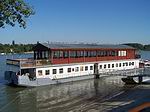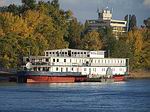| 1. high-speed crafts |
 a.) hydrofoils
a.) hydrofoils
A hydrofoil is literally a wing that attaches underneath a vessel. As a hydrofoil craft gains speed, the hydrofoils lift their hull out of the water, decreasing drag and allowing greater speeds. Average cruising speed: 32-35 knots. Average capacity: 45-120 pax.
Examples: VÖCSÖK-III, SÓLYOM-II, METEOR-IV-MODRA
|
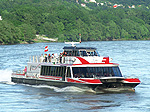 b.) jets and catamarans
b.) jets and catamarans
They are jet-propelled light aluminium catamarans for fast and comfortable suburban public transport. Due to their low draft and low wash, they could be able to operate in shallow water.
Example: TWIN CITY LINER
|
| 2. sightseeing and excrusion boats |
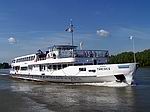 Pleasure boats for scheduled half or full-day trips and daytime sightseeing programs. Usually equipped with spacious open passenger compartment with bench seats. On board there is a buffet.
Pleasure boats for scheduled half or full-day trips and daytime sightseeing programs. Usually equipped with spacious open passenger compartment with bench seats. On board there is a buffet.
Examples: HUNYADI, NAGYMAROS (Moskva-type), STADT WIEN (paddle boat), waterbuses
|
| 3. event boats |
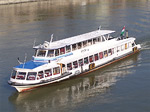 Riverboats with huge (air-conditioned, well-decorated) indoor space(s) are suitable for business meetings, banquets, conferences, wedding parties, etc. Average capacity: 12-1500 pax (it depends on the boat sizes/classes). Their general appearance is similar to excursion boats.
Riverboats with huge (air-conditioned, well-decorated) indoor space(s) are suitable for business meetings, banquets, conferences, wedding parties, etc. Average capacity: 12-1500 pax (it depends on the boat sizes/classes). Their general appearance is similar to excursion boats.
Examples: BUDAPEST, GRÓF SZÉCHENYI, LEÁNYFALU
|
| 4. river cruise ships |
 Is it a ship filled with passengers or a hotel filled with guests? It is actually both. These vessels are typically used for 6-16-days pleasure cruises. They looks like floating hotels provided with sun deck, swimming pool, restaurant, spacious lounge, sauna, etc. All guests can be accommodated in 2 or 3-beds cabins with private bathrooms. Vessels are manned by nautical crew and hotel staff too. Click here to browse all of them.
Is it a ship filled with passengers or a hotel filled with guests? It is actually both. These vessels are typically used for 6-16-days pleasure cruises. They looks like floating hotels provided with sun deck, swimming pool, restaurant, spacious lounge, sauna, etc. All guests can be accommodated in 2 or 3-beds cabins with private bathrooms. Vessels are manned by nautical crew and hotel staff too. Click here to browse all of them.
Examples: SOFIA, MOZART, RIVER QUEEN
|
| 1. motor freighters |
 a.) dry freighters
a.) dry freighters
These classic cargo vessels carry packaged items or loose form products such as containers, foods, furniture, machinery, coal, gravel, ore, etc. All these ships are self-propelled and have crew members. Some of them manage to tow or push barges or another freighters.
Examples: CICA, NORDENWIND, REGNITZ
|
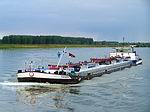 b.) tankers
b.) tankers
These vessels carry liquid goods like gasoline, acetol, biodiesel, etc. All these ships are self-propelled and have crew members. Some of them manage to tow or push barges or another freighters.
Examples: EILTANK 83, RAMSAU, MARIA LOUISE
|
 c.) Ro-Ro freighters
c.) Ro-Ro freighters
Roll-on/roll-off vessels are designed to carry wheeled cargo, such as cars, trucks, trailers that are driven on and off the ship on their own wheels. Not to be confused with ferry barges that go across the river. Ro-Ro ships are operate along the river with only one ramp on their bow. All these ships are self-propelled and have crew members.
Examples: HEILBRONN, KELHEIM, HAN TERVEL
|
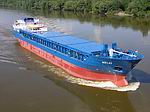 d.) river-sea going freighters
d.) river-sea going freighters
Examples: HAVI OCEAN, JEVENAU, NIKLAS
|
| 2. dumb barges |
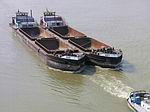 a.) pull-towed barges
a.) pull-towed barges
Pull-towed barges are shoal-draft flat-bottomed boat for transport of goods without propulsion but equipped by steering gear to be towed by tugboats.
|
 b.) push-towed barges (lighters)
b.) push-towed barges (lighters)
Push-towed barges are shoal-draft flat-bottomed boat for transport of goods without propulsion or steering gear to be pushed by pusher boats.
Compared to a towed barge, a pusher system has improved handling and is more efficient, as the pushing tug becomes "part of the unit" and it contributes to the momentum of the whole.
|
| 3. powerboats |
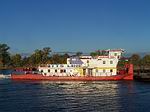 a.) pusher boats
a.) pusher boats
These boats are provided with powerful engines producing thousands of horsepower to push lighters and barges with high precision and economity.
Examples: MOHÁCS, NOVOSIBIRSK, MERCUR 303
|
 b.) tugboats
b.) tugboats
These boats are provided with powerful engines producing thousands of horsepower and extensive rigging equipment to tow classic cargo barges, disabled or distressed vessels, pontoons with high precision.
Examples: TATABÁNYA, ZAGORJE, DRAGASANI
|
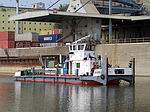 c.) small harbour tugs
c.) small harbour tugs
Harbour tugs are specially designed to offer the necessary support during the different maneuvers carried out by other vessels, dumb barges or floating devices within the port.
Examples: RENDEZŐ I, SAJÓ, MODRICA
|



 a.) hydrofoils
a.) hydrofoils b.) jets and catamarans
b.) jets and catamarans Pleasure boats for scheduled half or full-day trips and daytime sightseeing programs. Usually equipped with spacious open passenger compartment with bench seats. On board there is a buffet.
Pleasure boats for scheduled half or full-day trips and daytime sightseeing programs. Usually equipped with spacious open passenger compartment with bench seats. On board there is a buffet. Riverboats with huge (air-conditioned, well-decorated) indoor space(s) are suitable for business meetings, banquets, conferences, wedding parties, etc. Average capacity: 12-1500 pax (it depends on the boat sizes/classes). Their general appearance is similar to excursion boats.
Riverboats with huge (air-conditioned, well-decorated) indoor space(s) are suitable for business meetings, banquets, conferences, wedding parties, etc. Average capacity: 12-1500 pax (it depends on the boat sizes/classes). Their general appearance is similar to excursion boats.
 Is it a ship filled with passengers or a hotel filled with guests? It is actually both. These vessels are typically used for 6-16-days pleasure cruises. They looks like floating hotels provided with sun deck, swimming pool, restaurant, spacious lounge, sauna, etc. All guests can be accommodated in 2 or 3-beds cabins with private bathrooms. Vessels are manned by nautical crew and hotel staff too. Click here to browse all of them.
Is it a ship filled with passengers or a hotel filled with guests? It is actually both. These vessels are typically used for 6-16-days pleasure cruises. They looks like floating hotels provided with sun deck, swimming pool, restaurant, spacious lounge, sauna, etc. All guests can be accommodated in 2 or 3-beds cabins with private bathrooms. Vessels are manned by nautical crew and hotel staff too. Click here to browse all of them.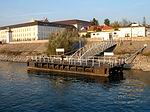 a.) classic piers
a.) classic piers b.) piers with superstructure
b.) piers with superstructure